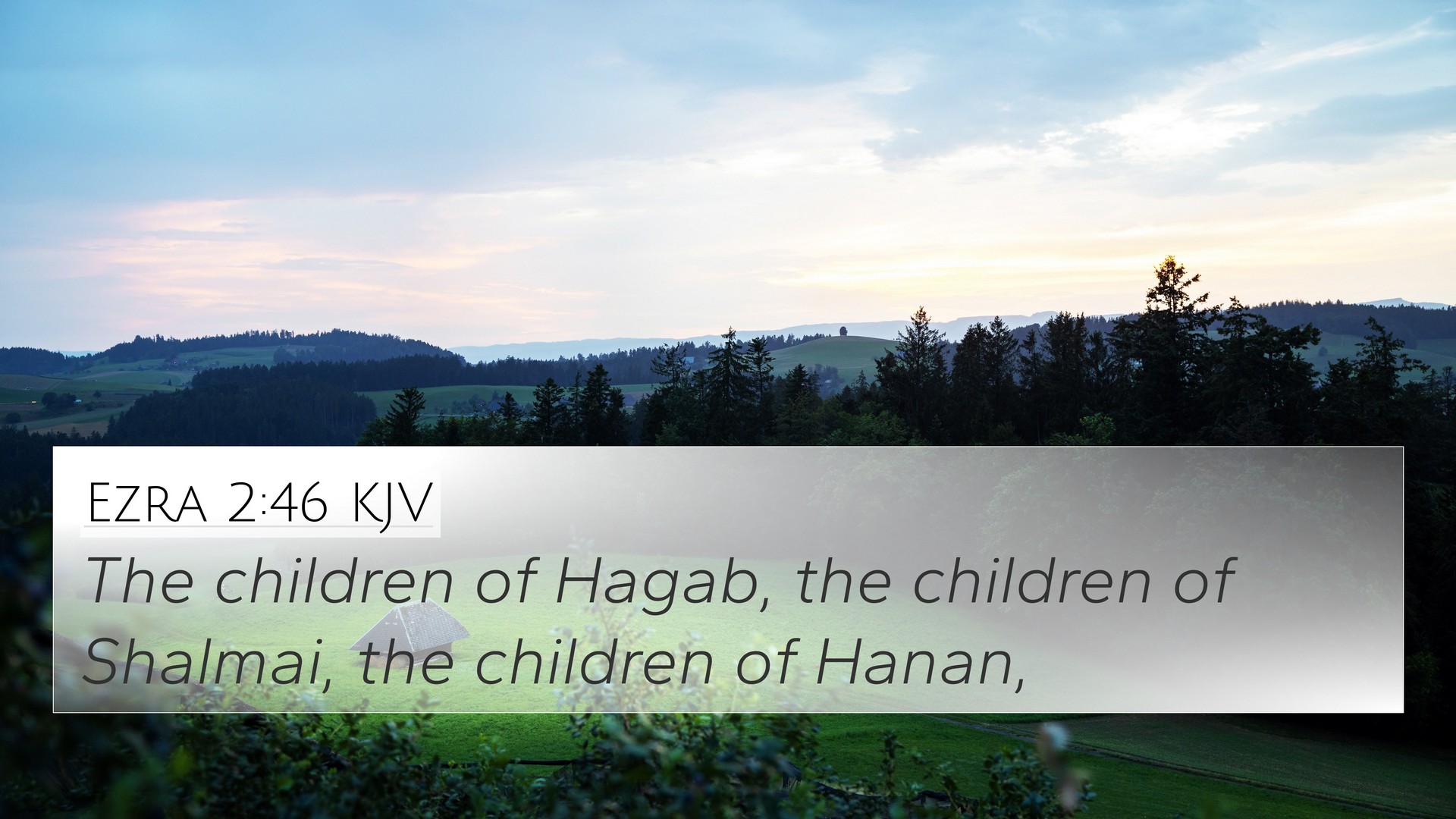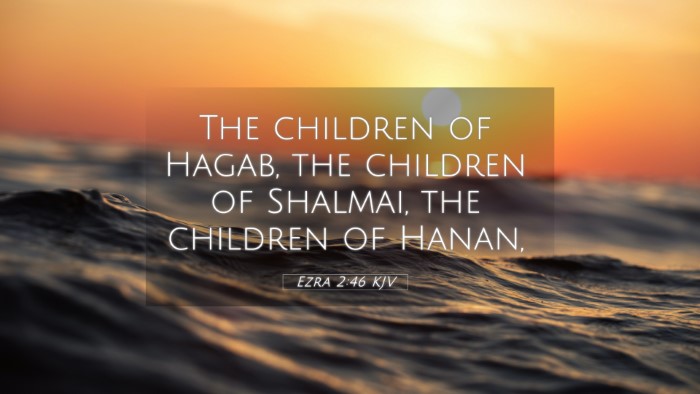Understanding Ezra 2:46
In the book of Ezra, Chapter 2, verse 46 speaks specifically of the servants of Solomon who were identified as part of the returning exiles. This verse holds significant contextual importance as it connects to themes of restoration, community, and the fulfillment of prophetic promises regarding God's people. Here, we delve into the meanings proposed by various public domain commentaries, integrating insights from Matthew Henry, Albert Barnes, and Adam Clarke.
Verse Context
Ezra 2:46 states:
"The Nethinims: the children of Ziha, the children of Hasupha, the children of Tobiah, the children of Keres." (Ezra 2:46, KJV)
This verse lists the families of the Nethinims, a group serving in temple activities, which emphasizes their role in the rebuilt community post-exile.
Commentary Insights
Matthew Henry
Matthew Henry remarks on the significance of these servants, identifying them as part of the spiritual and societal fabric of the Jewish people returning from Babylonian captivity. Their inclusion represents restoration and the continuation of God’s promise to bring His people back to their homeland, emphasizing the unity of the community in worship and service to God.
Albert Barnes
Albert Barnes highlights the function of the Nethinims, noting that they were dedicated to the service of the temple. This service was a continuation of what was established during Solomon’s reign, reflecting a continuity of worship practices. Barnes asserts that this mention signals the importance of having both priests and laypeople actively involved in worship, showcasing their value in the Israelite community as established by previous covenantal practices.
Adam Clarke
Adam Clarke provides a detailed exploration of the term "Nethinims," explaining that it refers to those designated for temple service, often viewed as "given ones." This term indicates that they were set apart for divine service, highlighting a key aspect of the cultic purity required in the temple worship. Clarke also notes that the diversity in the names listed indicates the inclusivity of various families within the returning group, illustrating how God cherishes a variety of service within His community.
Thematic Connections
Ezra 2:46 presents a significant opportunity for cross-referencing with numerous Bible verses that deal with themes of service, restoration, and the community of faith. Below are some key Bible verses that relate to Ezra 2:46:
- 1 Chronicles 9:2 - Lists the returning exiles who led service in the temple.
- Nehemiah 3:26 - Refers to the servants who were involved in rebuilding Jerusalem, emphasizing their commitment.
- Psalms 102:13 - Speaks of God’s favor upon Zion, connecting to the restoration theme.
- Isaiah 44:2 - Declares God’s promise of comfort and restoration to His people, reflecting the sentiments within Ezra.
- Malachi 1:6 - Discusses honor due to God by His servants, showcasing the importance of faithful service.
- Zechariah 8:7-8 - God’s promise to bring His people back to Zion, symbolizing restoration and community.
- Matthew 20:26-28 - Jesus teaches about servanthood, significantly relating to the Nethinims' role as servants.
Connections Between Bible Verses
This verse notably establishes connections between various parts of scripture, showcasing how Old Testament texts inform New Testament teachings about servanthood and community. Below are insights on how these biblical themes interweave:
- Connections are seen in service as a critical component of worship from Ezra’s time through to Jesus' teachings on humility and servitude.
- The restoration of the Israelite community in Ezra parallels the establishment of the church in Acts, where diverse groups come together for worship and service.
- The concept of being set apart for service echoes throughout scripture, particularly in the Pauline epistles which discuss the Body of Christ comprising many members serving different functions.
The Tools for Bible Cross-Referencing
Understanding and interpreting passages like Ezra 2:46 can be greatly enhanced using tools for bible cross-referencing. Below are recommended tools that could aid in deeper study and appreciation:
- Bible Concordance - A reference tool for finding scripture by keywords, helping to uncover thematic connections.
- Bible Cross-Reference Guide - Provides systematic lists of verses that relate to one another, aiding comparative studies.
- Cross-Reference Bible Study - Methodology for examining related verses and understanding their interconnections.
- Bible Reference Resources - Collections of commentaries and reference materials that provide insights on various biblical texts.
Conclusion
In summary, Ezra 2:46 serves as a pivotal verse that opens avenues for exploring themes of service, community, and restoration in the biblical narrative. The insights drawn from prominent commentaries enrich our understanding of the significance of the Nethinims and their role in the returning exiles' re-establishment of temple worship. Utilizing cross-referencing methods allows for a deeper exploration of scripture, facilitating connections between themes and enhancing our study of the Bible.


